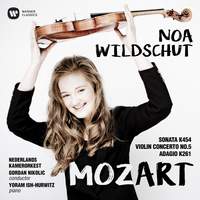Interview,
Noa Wildschut on Mozart
 Dutch violinist Noa Wildschut's rise seems meteoric, even by the standards of gifted young musicians; a television debut at age six, on stage at the Concertgebouw at seven and since then a packed schedule of collaborations with Europe's leading orchestras.
Dutch violinist Noa Wildschut's rise seems meteoric, even by the standards of gifted young musicians; a television debut at age six, on stage at the Concertgebouw at seven and since then a packed schedule of collaborations with Europe's leading orchestras.
She's now an exclusive recording artist for Warner Classics, with whom she has recorded her debut disc - choosing an all-Mozart programme mixing orchestral and chamber music. I spoke to her about this new album, and about her experiences as someone who has met great success while still very young.
You’ve spoken several times of the humour and joking quality in Mozart’s music – do you think the classical world sometimes takes the great composers too seriously and takes the fun out of their work?
That is a very interesting question! I honestly don’t think that the classical world takes the great composers too seriously, because I think it is very important to know a composer’s intention with a piece and to follow his ideas as much as possible. But I actually do think that people take the art of making music in general (sometimes) too seriously. The mentality of many people nowadays is that everything has to be (near to) perfect. I think it is a really good thing to have goals to strive for, but I think one should always take care that comparison and the urge for perfection never take away the joy in what you do.
Music is no competition, it is connection, bringing people together, and passing on emotions. I often find it hard to realize this myself as well, but I think on stage we just have to let go of the idea of doing everything perfectly and only focus on this main purpose of music, its ability to create feelings like joy and love. A few weeks ago I watched the film ‘Amadeus’, which of course is dramatized, but I still realized that Mozart himself was such a special man full of humour. Last week I played Mozart 5 in the Concertgebouw, and while playing, the only thing I had in mind was the character of Mozart, and his intention to give joy to people through his music.
With such a huge range of music from so many composers available to you, what led you to choose an all-Mozart programme for this album?
Mozart’s music is so pure and full of life and brightness. It is just like opera: there are many big contrasts and different characters in it. I always get such a happy feeling when playing his music! I wanted to combine a violin concerto with a concert piece and a sonata, to show really different sides of both Mozart and myself. And I wanted to combine the ‘old’ Mozart with something fresh, something young; this is why Max Knigge and I wrote new cadenzas.
The cadenzas in the concerto are the result of a collaboration between you and composer Max Knigge – how did this come about, and what was it like to create a new set of cadenzas for this popular and frequently-performed piece?
In the time of Mozart, a cadenza was the space for the soloist to improvise and play with the motifs that occurred in the movement. Nowadays, people often play written cadenzas like the cadenzas by Joseph Joachim, but I wanted to revive the tradition of creating something myself. But because I hadn’t done anything like this before, I asked a colleague of my father, the wonderful composer Max Knigge, if he could maybe help me with it. He wrote a really nice concept, and for me it was a bit of cutting and pasting and I composed some extra things myself. It was such a wonderful process!
Can you tell us about your relationship with Anne-Sophie Mutter? You’ve recorded with her on her Yellow Lounge album and played in her “Mutter’s Virtuosi” string ensemble – would you say she’s a big influence on your performance style?
Absolutely. I am beyond honoured to have been a scholar in her foundation since May 2015. Together with the Mutter’s Virtuosi we’ve had so many great concerts throughout Europe and America. I learn incredibly much from playing with her, I get so inspired by her enormously powerful and colourful playing and her intensity in vibrato. I think the most important thing I learned from her is to create and ‘improvise’ on stage: every time she plays a piece she plays it differently from the time before. That inspires me very much. Every month I send a report to Ms Mutter in which I describe all my activities in that month, so she knows everything I do and gives advice whenever necessary. She also financed two violin bows for me, for which I am extremely grateful.
You’re working with people who are mostly much older than you. Other artists who’ve had great success at an early age have found it rather a mixed blessing, at times feelingthey weren’t being taken seriously as musicians. Is this something you’ve also encountered?
No, actually I never encountered anything like that! :) When I play with other artists, it doesn’t matter whether they are older or younger, we just try to become one. That is exactly what I find so intriguing about music: it equalizes everyone and connects us all through one common language.
Noa Wildschut plays Mozart was released in September on Warner Classics.
Available Formats: CD, MP3, FLAC, Hi-Res FLAC, Hi-Res+ FLAC



